Related Research Articles
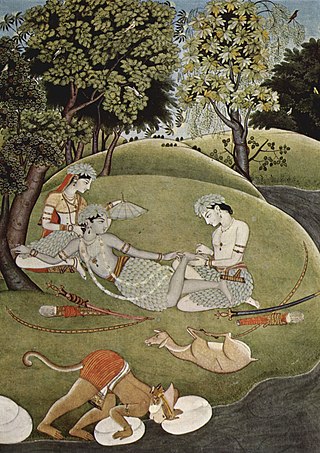
The Rāmāyana is a Sanskrit epic composed over a period of nearly a thousand years, with scholars' estimates for the earliest stage of the text ranging from the 2nd BC to 1st centuries AD, and later stages extending up to the 2nd century AD. Ramayana is one of the two important epics of Hinduism, the other being the Mahābhārata.

Ravana was a mythical multi-headed rakshasa (demon) king of the island of Lanka in Hindu mythology and the chief antagonist of the Hindu epic Ramayana and its adaptations. In the Ramayana, Ravana is described as the eldest son of sage Vishrava and rakshasi Kaikesi. He abducted Prince Rama's wife, Sita, and took her to his kingdom of Lanka, where he held her in the Ashoka Vatika. Later, Rama, with the support of vanara King Sugriva and his army of vanaras, launched an invasion against Ravana in Lanka. Ravana was subsequently slain, and Rama rescued his beloved wife Sita.

Hanuman, also called Anjaneya, is a Hindu god and a divine vanara companion of the god Rama. Hanuman is one of the central characters of the Hindu epic Ramayana. He is an ardent devotee of Rama and one of the Chiranjivis. Hanuman is regarded to be the son of the wind-god Vayu, who in several stories played a direct role in Hanuman's birth, and considered to be an incarnation of Shiva in Shaivism. Hanuman is mentioned in several other texts, such as the epic Mahabharata and the various Puranas.

Kubera also known as Kuvera, Kuber and Kuberan, is the god of wealth, and the god-king of the semi-divine yakshas in Hinduism. He is regarded as the regent of the north (Dikpala), and a protector of the world (Lokapala). His many epithets extol him as the overlord of numerous semi-divine species, and the owner of the treasures of the world. Kubera is often depicted with a plump body, adorned with jewels, and carrying a money-pot and a club.

'Pattadakal, also calledRaktapura, is a complex of 7th and 8th century CE Hindu and Jain temples in northern Karnataka (India). Located on the west bank of the Malaprabha River in Bagalakote district, this UNESCO World Heritage Site is 14 miles (23 km) from Badami and about 6 miles (9.7 km) from Aihole, both of which are historically significant centres of Chalukya monuments. The monument is a protected site under Indian law and is managed by the Archaeological Survey of India (ASI).

Nandi, also known as Nandikeshwara or Nandideva, is the bull vahana of the Hindu god Shiva. He is also the guardian deity of Kailash, the abode of Shiva. Almost all Shiva temples display stone-images of a seated Nandi, generally facing the main shrine.

Ramcharitmanas, is an epic poem in the Awadhi language, based on the Ramayana, and composed by the 16th-century Indian bhakti poet Tulsidas. This work is also called, in popular parlance, Tulsi Ramayana, Tulsikrit Ramayana, Tulsidas Ramayana or simply Manas. The word Ramcharitmanas literally means "Lake of the deeds of Rama". It is considered one of the greatest works of Hindu literature. The work has variously been acclaimed as "the living sum of Indian culture", "the tallest tree in the magic garden of medieval Indian poetry", "the greatest book of all devotional literature" and "the best and most trustworthy guide to the popular living faith of the Indian people".
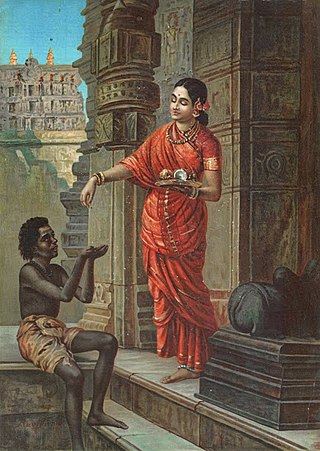
Mandodari was the queen consort of Ravana, the king of Lanka, according to the Hindu epic Ramayana. The Ramayana describes her as beautiful, pious, and righteous. She is extolled as one of the Panchakanya, the recital of whose names is believed to dispel sin.

Shiva Tandava Stotra is a Sanskrit stotra (hymn) that is dedicated to the Hindu deity, Shiva. Its authorship is traditionally attributed to Ravana, the King of Lanka, who is considered to be a great devotee of Shiva, composed during his plea for moksha.
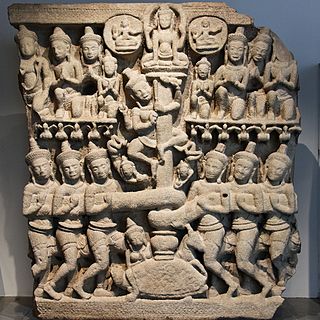
Hindu mythological wars are the wars described in the Hindu texts of ancient India. These wars depicted both mortals of great prowess as well as deities and supernatural beings, often wielding supernatural weapons of great power. Hindu teachings prescribe war as the final option, to be employed only after all peaceful methods are exhausted. Participation in righteous war, or dharmayuddha, was said to be honourable and was a principal duty of the Kshatriya or the warrior varna, and victory in such wars was regarded as a matter of honour.
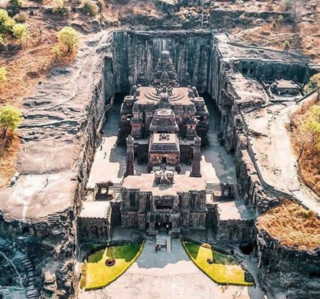
The Kailasha or Kailashanatha temple is the largest of the rock-cut Hindu temples at the Ellora Caves, Aurangabad District, Maharashtra, India. A megalith carved from a rock cliff face, it is considered one of the most remarkable cave temples in the world because of its size, architecture and sculptural treatment, and "the climax of the rock-cut phase of Indian architecture". The top of the superstructure over the sanctuary is 32.6 metres (107 ft) above the level of the court below, although the rock face slopes downwards from the rear of the temple to the front. Archaeologists believe it is made from a single rock.
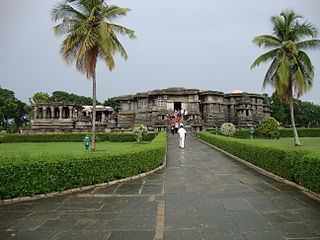
Hoysaleswara temple, also referred simply as the Halebidu temple, is a 12th-century Hindu temple dedicated to Lord Shiva. It is the largest monument in Halebidu, a town in the state of Karnataka, India and the former capital of the Hoysala Empire. The temple was built on the banks of a large man-made lake, and sponsored by King Vishnuvardhana of the Hoysala Empire. Its construction started around 1121 CE and was complete in 1160 CE. During the early 14th century, Halebidu was twice sacked and plundered by the Muslim armies of the Delhi Sultanate from northern India, and the temple and the capital fell into a state of ruin and neglect. It is 30 kilometres (19 mi) from Hassan city and about 210 kilometres (130 mi) from Bengaluru.
Murdeshwar is a town in Uttara Kannada district in the state of Karnataka, India, It is famous for the world's second tallest Shiva statue, the town lies on the coast of the Arabian Sea and is also famous for the Murudeshwara Temple. The town has a railway station on the Mangalore–Mumbai Konkan railway route.
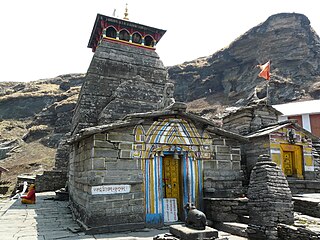
Tungnath (IAST:tuņgnāth) is one of the highest Shiva temples in the world and is the highest of the five Panch Kedar temples located in the Rudraprayag district, in the Indian state of Uttarakhand. The Tungnath mountains form the Mandakini and Alaknanda river valleys. It is located at an altitude of 3,690 m (12,106 ft), and just below the peak of Chandrashila. It has a rich legend linked to the Pandavas, heroes of the Mahabharata epic.
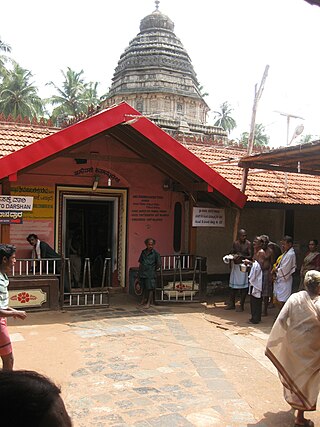
The Mahabaleshwar Temple, Gokarna is a 4th-century CE Hindu temple located in Gokarna, Uttara Kannada district, Karnataka state, India which is built in the classical Dravidian architectural style. It is a site of religious pilgrimage. The temple faces the Gokarna beach on the Arabian Sea. The temple deifies the Pranalinga also called Atmalinga or Shiva Linga In legend, it is said that the deity of the temple will bestow immense blessings to devotees, even to those who only glimpse it. Currently the administrative charge of the temple is with an Overseeing Committee under the Chairmanship of Justice BN Srikrishna, a Retired Justice of the Hon'ble Supreme Court of India. It is one of the 275 paadal petra sthalams expounded in the Tevaram, a sacred Tamil Shaivite text written during the 6th and 7th centuries by 63 saints called Nayanars.
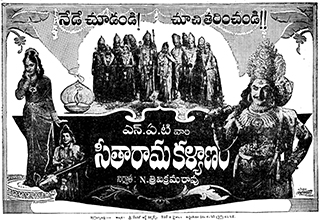
Sita Rama Kalyanam is a 1961 Indian Telugu-language Hindu mythological film directed by N. T. Rama Rao in his directorial debut. It stars N. T. Rama Rao, Haranath, Geetanjali, B. Saroja Devi, Kanta Rao, Sobhan Babu. The film was produced by N. Trivikrama Rao on 'National Art Theatres' banner. The music composed by Gali Penchala Narasimha Rao.

Ravananugraha or Ravananugraha-murti is a benevolent aspect of the Hindu god Shiva, depicted seated on his abode Mount Kailash with his consort Parvati, while the rakshasa-king (demon-king) Ravana of Lanka attempts to uproot it.

In some adaptations of the Hindu epic Ramayana, Maya Sita or Chaya Sita is the illusionary duplicate of the goddess Sita, who is abducted by the demon-king Ravana of Lanka instead of the real Sita.
References
- ↑ Bennett, James (7 June 2017). Beneath the Winds: Masterpieces of Southeast Asian Art from the Art Gallery of South Australia. Australia: Art Gallery of South Australia. p. 251. ISBN 978-1921668074.
- ↑ Cakrabartī, Bishṇupada (24 July 2008). The Penguin Companion to the Ramayana. Penguin. p. 91. ISBN 978-0143100461 . Retrieved 24 July 2018.
- ↑ Social, Daily. "12 Of The Most Powerful Divine Weapons From Hindu Mythology". Daily Social. Retrieved 24 July 2018.
- ↑ "Chandrahas". cleandungeon. Retrieved 24 July 2018.
- ↑ Rao pp.217–8
- ↑ Kala pp.37–8
- ↑ "Chandrahas". www.goodreads.com. Retrieved 9 May 2021.